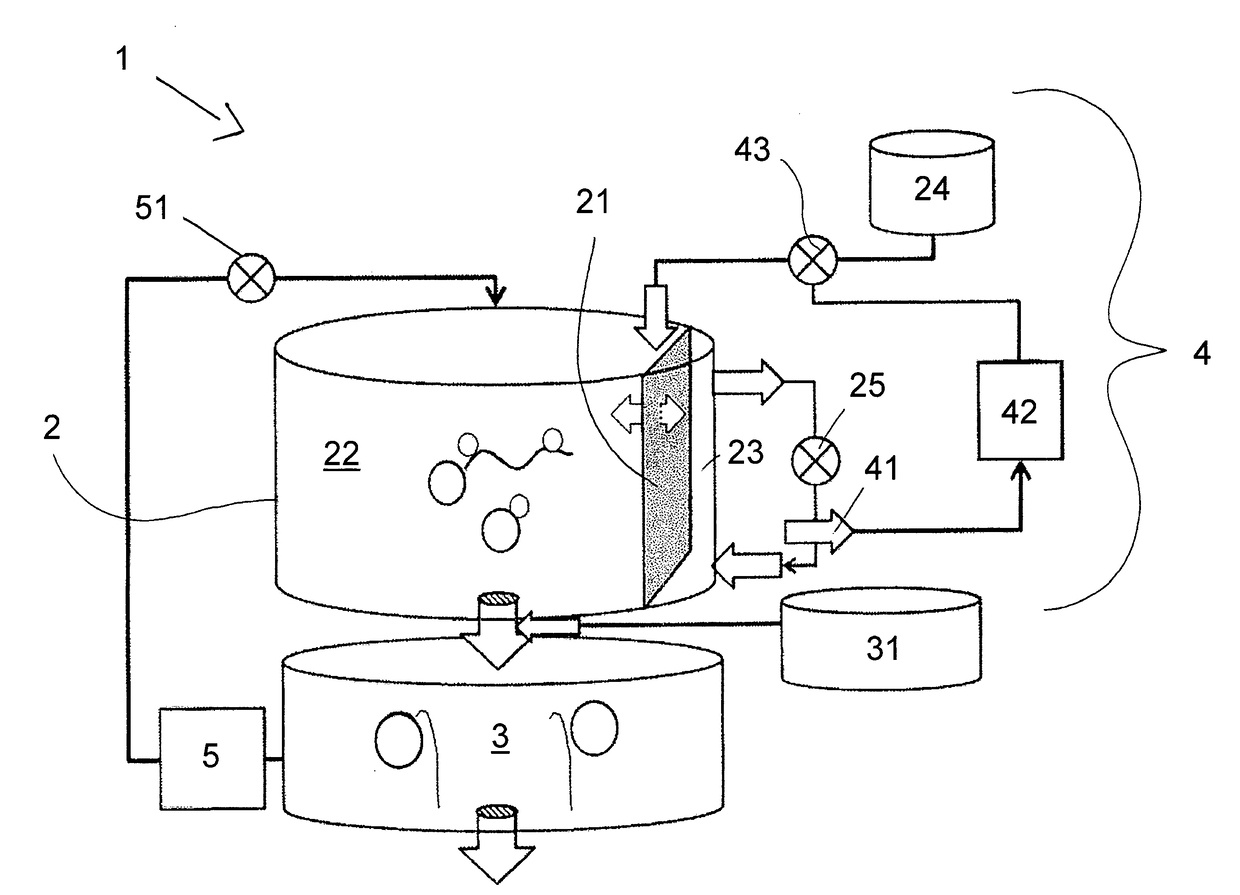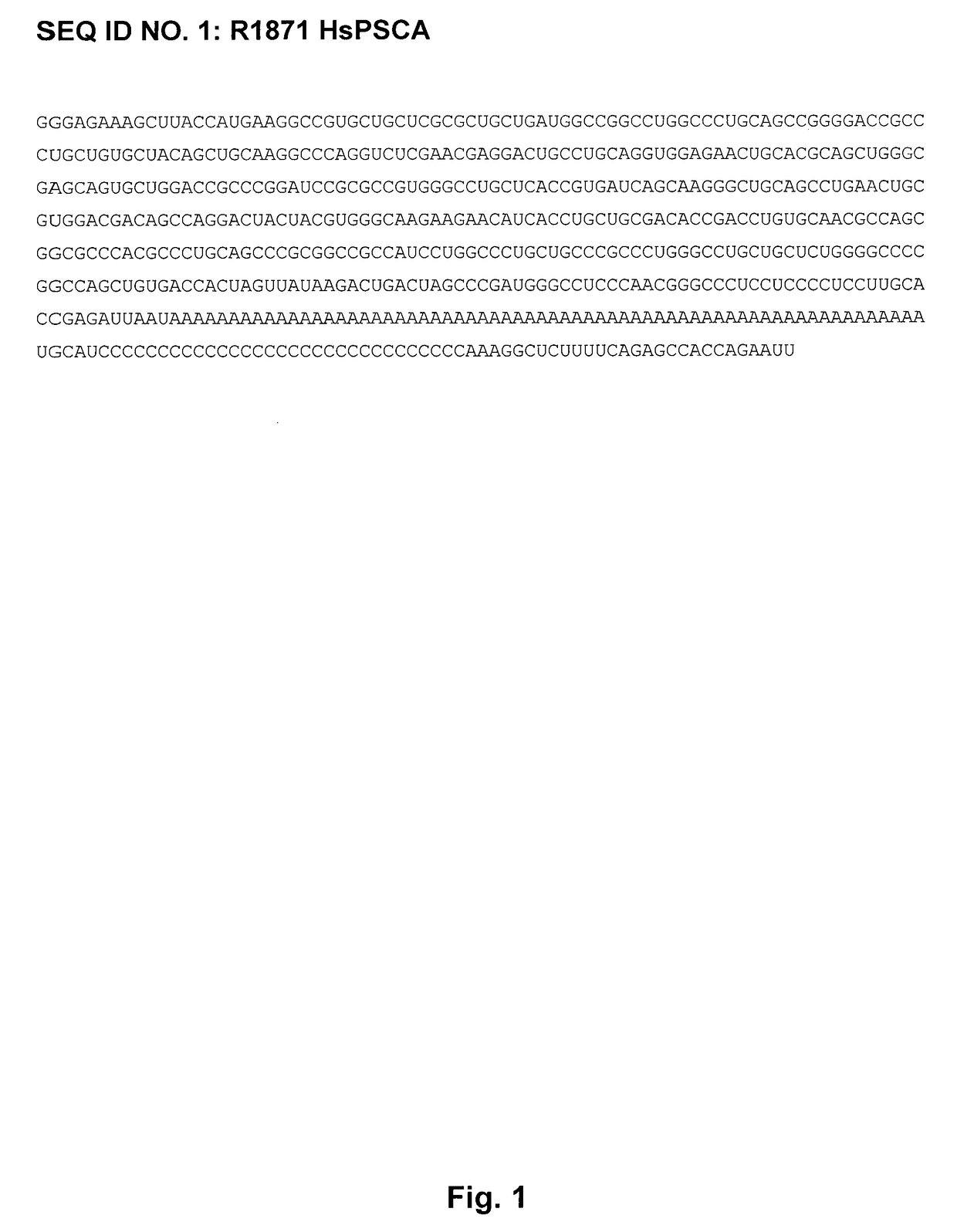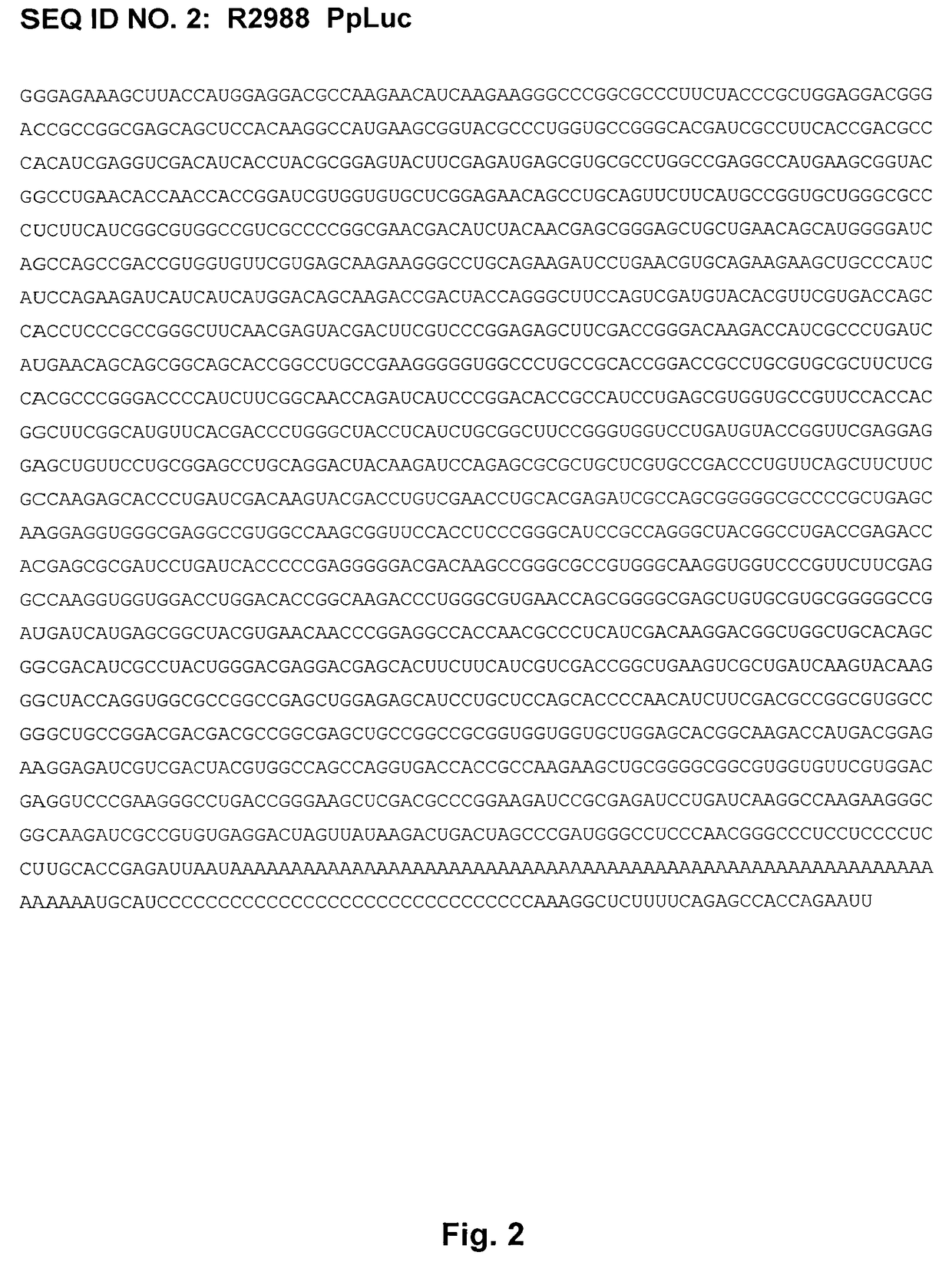Methods and means for enhancing RNA production
a technology of enhancing rna and enhancing utp concentration, which is applied in the direction of specific use bioreactors/fermenters, enzyme production/based bioreactors, biomass after-treatment, etc., can solve the problems of reducing the yield of full-length products, undesirable abortive transcripts, and lowering the concentration of utp, so as to achieve improved and economical means and methods
- Summary
- Abstract
- Description
- Claims
- Application Information
AI Technical Summary
Benefits of technology
Problems solved by technology
Method used
Image
Examples
example 1
on of the mRNA
[0187]1. Preparation of DNA and mRNA Constructs
[0188]For the present example DNA sequences encoding Homo sapiens prostate stem cell antigen (HsPSCA) mRNA (R1871), Photinus pyralis Luciferase (PpLuc) mRNA (R2988) and Mucin-1 signal peptide / epidermal growth factor receptor / Mucin-1 fusion protein (EGFR / Mucin-1) (R1626) were prepared and used for subsequent in vitro transcription reactions.
[0189]According to a first preparation, a vector for in vitro transcription was constructed containing a T7 promoter followed by a sequence coding for the above mentioned proteins. The constructs were prepared by modifying the wild type coding sequence by introducing a GC-optimized sequence for stabilization, followed by a stabilizing sequence derived from the alpha-globin-3′-UTR (muag (mutated alpha-globin-3′-UTR)), a stretch of 64 adenosines (poly-A-sequence), a stretch of 30 cytosines (poly-C-sequence), and a histone stem loop.
[0190]In addition, a vector for in vitro transcription was...
example 2
sis Assay
1. Principle of the Assay
[0215]The hammerhead ribozyme HHNUH2d (5′-GCAUGGCUGAUGAGGCCUCGACCGAUAGGUCGAGGCCGAAAAGCUUUCUCC C-3′) (SEQ ID NO: 5) was incubated with the in vitro transcribed RNAs of example 1 and the cleavage products were separated by denaturing polyacrylamide-gel-electrophoresis (dPAGE).
2. Ribozyme Cleavage Reaction
[0216]Per reaction, 10 pmol of HHNUH2d and 10 pmol of the respective generation 4 RNA were annealed in 0.625 mM EDTA in a total volume of 6 μl (2 minutes at 95° C., 0.1° C. / seconds to 25° C., 10 minutes at 25° C.). After addition of 4 μl of 100 mM MgCl2, 125 mM Tris / HCl, pH 7.5 (final concentration 40 mM MgCl2, 50 mM Tris / HCl), the reaction was incubated at 25° C. for one hour. For analysis via PAGE, the 1× reaction was stopped with 30 μl 95% formamide, 20 mM EDTA.
3. Gel Separation, Quantification of Cleavage Products and Calculation of Capping Degree
[0217]Stopped reactions were heat-denatured (heated to 80° C. for 2 minutes, immediately put on ice fo...
example 3
n of RNA Yields Using UTP and Pseudo-UTP in Sequence-Optimized Nucleotide Mixes
[0220]In vitro transcription reactions can be performed by replacing one or more of the four nucleotides ATP, GTP, CTP and UTP by nucleotide analogs. Examples of such modified NTPs are pseudouridine (psU or Ψ) triphosphate and 5-methylcytidine (5mC) triphosphate. The percentage of the modified nucleotide in the mix can be varied from 0% to 100% of the natural nucleotide that it replaces.
[0221]To test whether it is possible to use modified nucleotides such as pseudouridine (psU) triphosphate in sequence-optimized nucleotide mixes, UTP was replaced by 10%, and 100% pseudouridine triphosphate. In a control reaction, 100% UTP was used.
Sequence-Optimized In Vitro Transcription in the Presence of Cap Analog
[0222]For sequence-optimized in vitro transcription reactions the concentration of ribonucleoside triphosphates (NTPs) was calculated for each individual sequence according to the nucleotide composition of th...
PUM
| Property | Measurement | Unit |
|---|---|---|
| Fraction | aaaaa | aaaaa |
| Digital information | aaaaa | aaaaa |
| Digital information | aaaaa | aaaaa |
Abstract
Description
Claims
Application Information
 Login to View More
Login to View More - R&D
- Intellectual Property
- Life Sciences
- Materials
- Tech Scout
- Unparalleled Data Quality
- Higher Quality Content
- 60% Fewer Hallucinations
Browse by: Latest US Patents, China's latest patents, Technical Efficacy Thesaurus, Application Domain, Technology Topic, Popular Technical Reports.
© 2025 PatSnap. All rights reserved.Legal|Privacy policy|Modern Slavery Act Transparency Statement|Sitemap|About US| Contact US: help@patsnap.com



